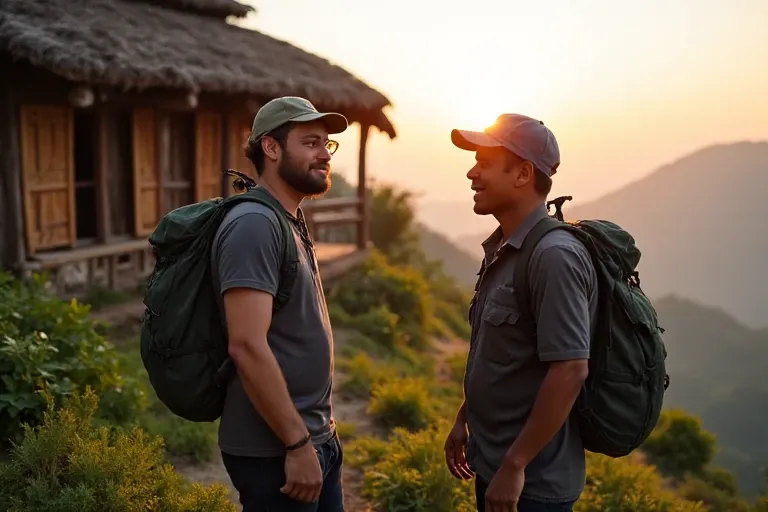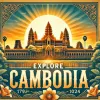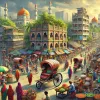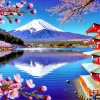My backpacking adventures have taken me across Southeast Asia, from the bustling markets of Bangkok to the serene rice paddies of Vietnam. But nothing quite prepared me for the unexpected journey I embarked on in Yunnan, China – a deep dive into the fascinating world of the Deang people, a minority within a minority, their villages tucked away in the mountains along the precarious China-Myanmar border. This wasn’t your typical tourist trail; this was a true exploration, a journey into the heart of a culture largely unknown to the outside world.
From Urban Exploration to Mountain Majesty
My fourth day in Mangshi began like any other – navigating the city's vibrant streets, savoring the local cuisine, and soaking in the bustling energy. But a chance conversation with a local driver altered my plans dramatically. He spoke of a remote Deang village nestled high in the Three Pagodas Mountain (San Tai Shan) range, painting a vivid picture of a culture distinct from the Dai people I'd already encountered. The allure of the unknown, the promise of a hidden cultural gem, was too compelling to ignore.
Leaving behind the concrete jungle, I ventured into the countryside, passing through fields of corn that stretched as far as the eye could see. The air, crisp and clean, was a stark contrast to the city’s fumes. I watched, mesmerized, as truck after truck rumbled past, laden with watermelons, a testament to the region’s bountiful agricultural landscape. This wasn't just a scenic drive; it was a transition into a different world, a prelude to the adventure that awaited.
The Winding Road to Chudonggua: A Journey into the Heart of the Mountains
The taxi ride became an adventure in itself. The road, a ribbon of asphalt winding ever higher, tested my sense of balance as we climbed into the mountains. The driver, a jovial man with a wealth of local knowledge, regaled me with stories of the region’s role in World War II, recounting tales of strategic mountain passes and the destruction of bridges during the Japanese invasion. He painted a vivid picture of the area as a crucial battleground, highlighting its significance on the Burma Road and its pivotal role in disrupting enemy supply lines. The sheer history embedded within this landscape was palpable, a potent combination of thrilling adventure and a compelling history lesson unfolding before me.
The higher we climbed, the more remote the area became. The lush green landscape unfolded before my eyes, transforming from cultivated fields to dense, untouched forest. We passed through small hamlets, their houses scattered amidst the verdant hillsides – a testament to the harmony between nature and human habitation. The climb took us to over 1380 meters above sea level, a significant altitude that made me feel truly removed from the modern world. The air thinned with each upward turn, my breath growing shorter, but my anticipation growing even greater.
Chudonggua Village: A Living Tapestry of Deang Culture
Finally, after a truly unforgettable ascent, we arrived in Chudonggua Village. The view was breathtaking. The village itself was a sight to behold, its houses nestled amidst the hillsides, offering spectacular views of the Shan State in Myanmar across the border. This wasn't simply a village; it was a living museum, a testament to the enduring spirit of the Deang people.
What struck me most was the tranquility and the palpable sense of community. Life here moved at a slower pace, unhurried and unburdened by the frenetic energy of city life. I was struck by the way the villagers, amidst the challenges of this remote location, had managed to maintain a rich and vibrant culture, preserving their traditions and way of life for generations. I spent hours wandering through the village, captivated by the details. The houses, built with traditional techniques using bamboo and local materials, spoke volumes about the ingenuity and resourcefulness of the Deang people.
Encounters and Exchanges: Glimpses into Deang Daily Life
My interactions with the villagers were nothing short of extraordinary. I encountered a four-and-a-half-year-old child who, despite her tender years, demonstrated a remarkable awareness of her surroundings, confidently identifying local fruits and plants. This child was a testament to the deep connection between the young generation and their cultural heritage.
I spoke with the villagers, learning about their farming practices, their crafts, and their daily lives. They were incredibly welcoming, their kindness and generosity shining through their smiles. I was introduced to the fruits of their labor, tasting exotic and delicious plants unique to this remote region. I observed the mundane yet meaningful moments: a grandmother returning home with her groceries, children tending to their rabbits, the quiet rhythm of their everyday tasks. The sights, the sounds, and the simple interactions painted a rich and vivid picture of their lives. The use of bamboo was striking; it formed an essential part of their construction, their tools, and their daily lives.
A Culinary Journey: Savoring the Flavors of Deang Cuisine
One of the most memorable moments of my visit was an invitation to share a meal with a Deang family. This wasn't just a meal; it was a profound cultural exchange. The food was simple, yet utterly delicious, highlighting the freshness of locally-sourced ingredients. I savored the earthy flavors, the unique textures, and the simplicity of the preparations. It was a culinary testament to their connection to the land, their culinary traditions, and their deep-rooted respect for nature.
The meal itself was more than just nourishment; it was a window into their traditions and hospitality. It was a celebration of community, a sharing of culture, and a testament to the profound warmth and generosity of the Deang people. The flavors were a reflection of the land, simple and pure, a true reflection of their environment and culinary history. The hearty meal, shared with laughter and conversation, cemented the feeling of welcome I felt throughout my visit.
Beyond the Village: Mangshi and its Contrasting Charms
My Yunnan adventure extended beyond Chudonggua Village. I explored Mangshi, the nearby city, contrasting the energy of urban life with the serenity of the mountain village. I visited the city's bustling square, the central hub of activity, envisioning the upcoming water festival and the vibrant atmosphere it would bring.
The culinary experiences continued, as I indulged in the city's diverse culinary scene, sampling Burmese snacks and local Yunnan specialties. The city’s energy, the vibrancy of its markets, and the bustle of daily life provided a fascinating counterpoint to the tranquil world I had left behind in the mountains. This juxtaposition enriched my understanding of Yunnan, highlighting the distinct character of each place and demonstrating the interconnectedness of urban and rural life.
My explorations extended to the Meng Huan Golden Pagoda and the Silver Pagoda, which offered breathtaking panoramic views of the city and the surrounding landscape. The pagodas, imbued with history and serenity, provided a welcome respite from the city's dynamism. The stillness, the beauty of the architecture, and the aura of peace that permeated the sites offered a profound contrast to the bustling energy of the city, enriching my Yunnan experience.
Reflections on an Unforgettable Journey
My journey to Deang country was far more than a simple sightseeing trip; it was a transformative experience. It was a deep dive into a culture rich in tradition and deeply connected to its environment. It was a chance to connect with a vibrant community, to experience their genuine hospitality, and to gain an insight into a way of life often overlooked.
The juxtaposition of the tranquil mountain village and the vibrant city of Mangshi underscored the diverse tapestry of life in Yunnan. The trip was a celebration of contrast, a blend of the traditional and the modern, the serene and the dynamic. It challenged my assumptions, broadened my understanding of cultural diversity, and left an indelible mark on my soul. It was an unforgettable journey that will forever hold a special place in my heart. It's a trip I will undoubtedly be recounting for years to come, and one that I wholeheartedly recommend to anyone seeking a truly unique and enriching travel experience.
Key Takeaways: Deang Culture at a Glance
| Feature | Description |
|---|---|
| Location | Primarily in Yunnan Province, China, bordering Shan State, Myanmar. |
| Population | A small minority group within Yunnan, with an estimated population of around 22,000 in China. |
| Language | Deang, with many also fluent in Dai, Chinese, and Jingpo languages. |
| Religion | Primarily Theravada Buddhism, reflecting the influence of neighboring cultures. |
| Architecture | Distinctive bamboo houses, often built on stilts, showcasing unique architectural designs. |
| Cuisine | Fresh, locally-sourced ingredients, simple preparations, reflecting a deep connection to the land. |
| Culture | Rich traditions, distinct from neighboring ethnic groups. A focus on community and the preservation of their heritage. |







